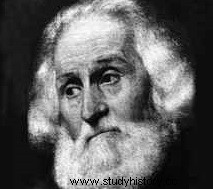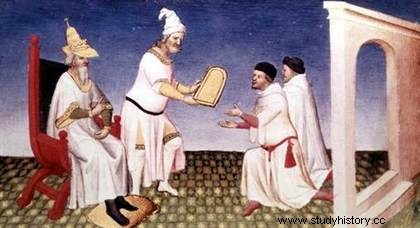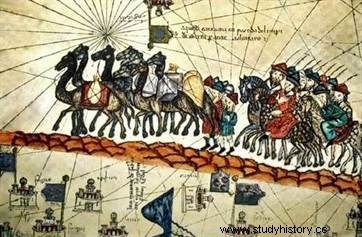 Marco Polo was a Venetian merchant, explorer and writer, whose writings gave Europeans their first glimpse of life in the Far East. From 1271, he crossed all of Asia along the famous Silk Road, taking advantage of the period of the "pax mongolica" of the Mongol Empire, when artistic and commercial exchanges were actively developing between China, Genoa and Venice. He remained sixteen years in the service of Kublai Khan. The account of his travels, partly fictionalized, is the first European document on Mongolian China. For several centuries, this Book of the wonders of the world will be for Europeans the only source of information on the Far East.
Marco Polo was a Venetian merchant, explorer and writer, whose writings gave Europeans their first glimpse of life in the Far East. From 1271, he crossed all of Asia along the famous Silk Road, taking advantage of the period of the "pax mongolica" of the Mongol Empire, when artistic and commercial exchanges were actively developing between China, Genoa and Venice. He remained sixteen years in the service of Kublai Khan. The account of his travels, partly fictionalized, is the first European document on Mongolian China. For several centuries, this Book of the wonders of the world will be for Europeans the only source of information on the Far East.
Origin of Marco Polo and journey to the Far East
Marco Polo was born on September 15, 1254 in Venice into a family of merchants. When he was a child, his father, Niccolo, and his uncle, Matteo Polo, completed a commercial journey of more than fifteen years, which took them from the Crimea to Central Asia and China, to the court of the Mongol Emperor Kublai. Returning to Venice in 1269, Niccolo and Matteo left again in 1271, taking with them the young Marco, then seventeen years old.
 After stopping in Acre, Syria, the travelers reached Sivas, among the Seldjouks, then crossed the Armenia, Persia, Afghanistan, Central Asia, then go up the Oxus to the Pamir which they cross to then follow the mountain range of the Tian Shan and reach the region of Lob Nor, in the Tarim basin ( Chinese Turkestan, currently Xinjiang Autonomous Region).
After stopping in Acre, Syria, the travelers reached Sivas, among the Seldjouks, then crossed the Armenia, Persia, Afghanistan, Central Asia, then go up the Oxus to the Pamir which they cross to then follow the mountain range of the Tian Shan and reach the region of Lob Nor, in the Tarim basin ( Chinese Turkestan, currently Xinjiang Autonomous Region).
They finally crossed the Gobi desert and arrived in 1275 at the court of Kublai Khan, installed in Cambaluc (Dadu des Yuan or Khanbalik), the new capital of China since 1267 (near present-day Beijing). Under the reign of Kublai Khan, the Mongol empire was at its height:trade along the Silk Road was then uninterrupted between China and the Middle East, and Western travellers, including Marco Polo, could visit in China.
While Jean du Plan Carpin and Guillaume de Rubrouck crossed Asia as far as Mongolia a few years earlier, the Venetians were the first Europeans to really visit the regions they cross during their journey, including the Pamirs and the Gobi Desert.
Marco Polo in the service of the Mongol Emperor
They were warmly received by Kublai Khan, who took a particular liking to Marco, who quickly became familiar with the Mongolian language and customs. The young Polo then entered the diplomatic service of the Mongol emperor; he is its representative during numerous missions in different parts of the empire and, for three years, also assumes the function of governor of the Chinese city of Yang-chou; its exact role, however, remains unknown today. His father and his uncle occupy, as for them, the functions of military advisers of Kublaï. They remained in China until 1292.
The emperor finally allows them to return home. They then accompany a Mongolian princess on her way to Iran, a country they reach by crossing Sumatra, southern India, the Indian Ocean and the Persian Gulf. They continued their journey by land, passing through Tabriz, in present-day northern Iran, along the eastern coast of the Black Sea, before reaching Constantinople. They returned to Venice towards the end of 1295, bringing with them considerable wealth that amazed their compatriots.
 In 1298, Marco Polo was at the head of a Venetian galley and participated in a battle between the fleet from Venice to that of Genoa. On this occasion, he was taken prisoner by the Genoese and dictated to a cellmate (Rustichello of Pisa) the detailed account of his travels. He was freed in 1299 and returned to Venice, which he would not leave until his death on January 8, 1324. He was buried in the church of San Lorenzo.
In 1298, Marco Polo was at the head of a Venetian galley and participated in a battle between the fleet from Venice to that of Genoa. On this occasion, he was taken prisoner by the Genoese and dictated to a cellmate (Rustichello of Pisa) the detailed account of his travels. He was freed in 1299 and returned to Venice, which he would not leave until his death on January 8, 1324. He was buried in the church of San Lorenzo.
The Book of the Wonders of the World
The story of Marco Polo called the Book of the Wonders of the World is the most famous book in all of travel literature. It traces the adventures of the Venetian explorer and merchant who lived at the court of the great khan. In this poetic account, an important testimony to the era of the first geographical explorations, the tone is that of a spectator marveling at the riches and enchantments of Asian manners and customs, as in this famous passage devoted to an enchanting description of the residence Great Khan's Summer Camp in Ciandu (now Shang-tu). The book is therefore a merchant's manual as much as a travelogue. Composed essentially of long geographical descriptions of the Chinese cities and provinces of the 13th century, this travel account reflects, through its constant concern for beliefs and cults, a Christian and missionary concern.
According to a legend born in the 16th century, the three merchants reappeared in Venice around 1295, similar to Tartars. Three years later, Marco Polo, then commander of a galley, was captured during a naval battle between Venice and Genoa. It was in a Genoese prison that he would have reported his travels to his cellmate Rustician of Pisa, a reviser of Arthurian novels who is said to be the main editor of the book. But this "imprisonment" is suspected to be an invention of Rusticien, and it is quite likely that Marco Polo wrote a first version himself, now lost.
The story of Marco Polo, a source of information and inspiration
First published in langue d'oïl (between 1310 and 1315, under the title Motto of the world , copy by Thibaut de Chepoy, revised by his son Jean), this story, embellished with a profusion of details, brings to medieval Europe the first serious knowledge of China and other Asian countries:Siam, Japan, Java, Cochinchina, Ceylon, Tibet, India and Burma. Another Latin translation, completed in Bologna around 1320, was a huge success throughout Europe. In 1553, the Venetian Ramusio published a new version enriched with imaginary scenes - such as that of the return to the fold of the three travelers - forging the legend and making the book a geographical reference work even if, to read it carefully, the route described stay whimsical.
A remarkable work for the reader curious about exoticism, the Book of the wonders of the world is above all a literary work written with the aim of pleasing and entertaining; in this sense, it has not lost its power.
This account by Marco Polo was for a long time the only source of information on the geography of the Far East in Europe and served as the basis for some of the first accurate maps of Asia carried out in Europe. He also aroused curiosity and influenced Christopher Columbus, and his interest in the Orient led him to set up his journey in 1492; relying on Marco Polo's description, the Spanish navigator indeed sailed straight west from Europe, with the aim of reaching the Far East. Finally, the book suggests the existence of an entirely maritime route linking Europe to the Far East and circumventing Africa, a route finally taken in 1497-1498 by the Portuguese navigator Vasco de Gama.
Bibliography
- Marco Polo, Journey on the Silk Road, by Philippe Menard. Glénat, 2019.
- Marco Polo, biography of Jacques Heers. Fayard, 1983.
- The Book of Wonders by Marco Polo. Larousse, 2009.
